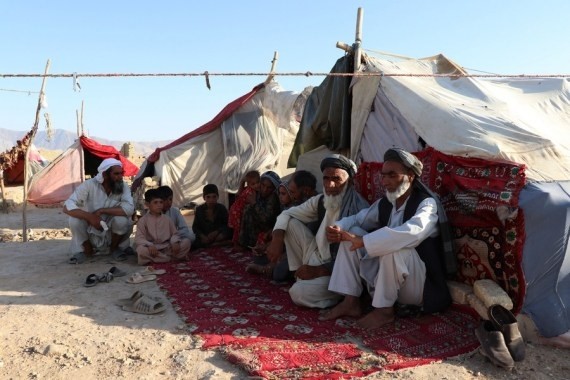

People at a camp for the displaced in Mazar-i-Sharif, capital of northern Balkh province, Afghanistan in July 2021 (Photo: Kawa Basharat/Xinhua/IANS)
The Afghan regime’s announcement of the relocation of Tehreek-e-Taliban Pakistan (TTP) cadre from the Afghanistan-Pakistan border, the Durand Line, to pacify Islamabad has upset communities within Afghanistan.
Earlier this month, the spokesperson for the Taliban, Zabiullah Mujahid had said that Kabul plans to assuage Islamabad that it does not harbour any anti-Pakistan elements.
Muhajid had said: “We will relocate only those refugees from the Durand Line to other provinces who pose a threat to Pakistan. Those posing no threat to Pakistan will not have their status affected”. Pakistan has been asking Kabul to intervene with the TTP in a bid to reduce massive violence against its security forces, particularly in the Khyber Pakhtunkhwa and Balochistan regions, where hundreds of Pakistani security personnel have been killed.
However, this decision has caused suspicions within Afghanistan’s ethnic communities, many of which feel that it is a ploy by the Taliban to change demographics.
The Afghanistan Freedom Front (AFF) said that the Taliban is changing the demographic structure of northern Afghanistan and is facilitating long-lasting extremism in the area. It added that such a move could facilitate long-lasting extremism in the region and pose a threat to world peace.
It is not just the AFF. Even the anti-Taliban group, the National Resistance Front of Afghanistan (NRF) led by Ahmad Masood, has promised to oppose the Taliban administration’s attempt to relocate the TTP to northern areas. The Khorasan Diary quoted Ali Maisam Nazary, the NRF’s head of foreign relations as saying: “We strongly condemn the Taliban plans to establish settlements for the TTP in Northern Afghanistan”, adding that such a move will not stabilise Afghanistan.
Suspicions have mounted against the Taliban as it has faced resistance in the northern parts of the country.
It was barely a fortnight back that Nisar Ahmad Ahmadi, the deputy governor of Badakhshan province, that borders Tajikistan, China and Pakistan, was killed in a car bombing. Eleven more people died in another bomb explosion that took place in a mosque where Ahmadi’s memorial service was being held. ISIS took responsibility for the car bombing against the Taliban official as attacks in urban centres between the Taliban and the ISIS mount.
Even as the Taliban will have to comprehend the opposition and ethnic tensions within the country over the relocation of the TTP, this is not the first time it is trying to win over foreign friends by moving fighters away from its border districts.
Soon after coming to power in August 2021, in the messy aftermath of the American withdrawal from Afghanistan after two decades, the Taliban had shifted Uyghur militants from its narrow border with China. Beijing had begun moving close to the Taliban soon after US plans to vacate Afghanistan became public. It even hosted a Taliban delegation in Beijing with a view to filling up the vacuum.
The Taliban promptly moved the East Turkestan Islamic Movement (ETIM) fighters from north-eastern Badakhshan province to the eastern Nangarhar region bordering Pakistan. China has long feared that the ETIM fighters could spark violence in its restive Muslim-dominated western province of Xinjiang where the Uyghurs seek an independent Xinjiang, also called East Turkestan.
Over the last almost-two years, relations between the Taliban and the Chinese government have shown marked improvement in the areas of trade and investment with China eyeing Afghanistan’s vast untapped resources of oil and minerals.
Coming back to the TTP and Pakistan, even if the Taliban move the TTP cadre away from the Durand Line provinces of Kunar, Khost and Paktika, they will never be too far away not to reach Pakistan if the need arises. Also, the Taliban’s move comes at a time when the TTP’s onward march from the Afghan borderlands has continued deep into Pakistan’s provinces by way of attacks and formation of new administrative units.
It was only last week that the TTP had announced a new administrative district in the Balochistan areas of Kalat and Makran. Many Baloch groups have been joining the TTP in a highly nationalist Balochistan, which has caused concern not just among the Pakistani government but also among the Leftist Baloch groups.
Only time will tell whether the Taliban’s move is an eye-wash or is a sincere attempt at placating Pakistan in the shifting sands of the Af-Pak region with fighters changing loyalties at the drop of a hat.
India decisively asserted its military superiority over Pakistan during this month's brief but intense conflict,…
Trade associations and local business groups in Pakistan-occupied Gilgit-Baltistan (PoGB) launched an indefinite protest on…
A human chain and protest march was organized by various organizations in front of the…
The United States on Saturday announced the expansion of its security partnerships with India through…
Highlighting the use of indigenous platforms during Operation Sindoor, Chief of Defence Staff (CDS) General…
Congress MP Shashi Tharoor on Friday (local time) said that Colombia will issue a statement…